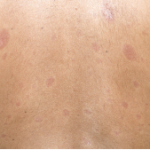A Most Mysterious Ailment
Scleroderma is a most vexing illness. First, there is the issue of what to call this disease.
Two of our former colleagues, whose names are synonymous with scleroderma, Thomas Benedek, MD, professor emeritus, and the late Gerald Rodnan, MD, both of the University of Pittsburgh, catalogued more than twenty different terms that have been used to describe this condition.3 Recently, there has been a shift towards adopting the more comprehensive term, systemic sclerosis (SSc), which includes the potentially devastating aspects of the illness that are not so readily visible. Second, the absence of a sensitive diagnostic test has made the diagnosis of early disease quite challenging. More commonly, patients present with advanced features of fibrosis, such as finger contractures and lung disease. Managing their illness can be highly challenging, since the course of SSc is often hard to predict. Third, it is not exactly clear how SSc begins. According to the 2013 ACR/European League Against Rheumatism criteria, the pathogenesis of SSc is characterized by three features: a small vessel vasculopathy, the production of autoantibodies, and the development of fibroblast dysfunction leading to increased deposition of extracellular matrix.4 Yet, how do these pathways interact with one another? Which one precedes the others? Does the universal finding of Raynaud’s phenomenon in patients with SSc suggest a vascular-based etiology? Why does the disease follow an implacable course in some individuals while remaining static in others?
Unlike other rheumatologic diseases, the therapeutic armamentarium for SSc is fairly limited. It is not clear whether our standard immunosuppressive therapies have any useful role to play. At present, mitigating fibrosis remains out of therapeutic reach. Instead, drugs that target vascular structures, such as prostanoids, endothelin-1 receptor antagonists, angiotensin-converting enzyme inhibitors, and inhibitors of phosphophodiesterase-5 (PDE5)may provide benefit to selected patients. For example, the selective inhibition of tyrosine kinase by imatinib interferes with the signaling of both platelet-derived growth factor (PDGF) and transforming growth factor (TGF) β, two pivotal mediators of the fibrotic process in SSc. After showing some promise in early studies, subsequent larger trials have been disappointing.
A new approach that aims to identify the key processes responsible for tissue fibrosis has focused on a well-known signal transduction pathway that has been known to play an important role in embryonic development and carcinogenesis. This highly conserved wingless-related integration site pathway, better known as Wnt signaling, consists of proteins with some impish names such as Frizzled and Dishevelled. A recent study demonstrated that the canonical Wnt pathway is activated in fibrotic diseases and potently stimulates fibroblast activation and tissue fibrosis.5 TGF-β signaling decreases the expression of Dickkopf-1 (Dkk-1) and activates the Wnt pathway. In fact, inhibition of canonical Wnt signaling by overexpression of Dkk-1 significantly reduced the profibrotic effects of TGF-β, demonstrating that the interaction of the canonical Wnt pathway and TGF-β may play a key role in the pathogenesis of fibrotic diseases. Could a disease as difficult to treat as SSc be tamed via the overproduction of Dkk-1, whose name, in German, means stubborn or obstinate?

